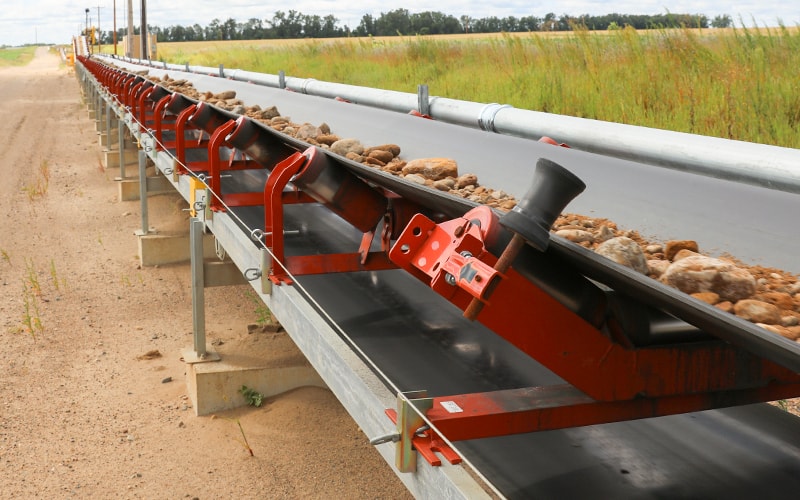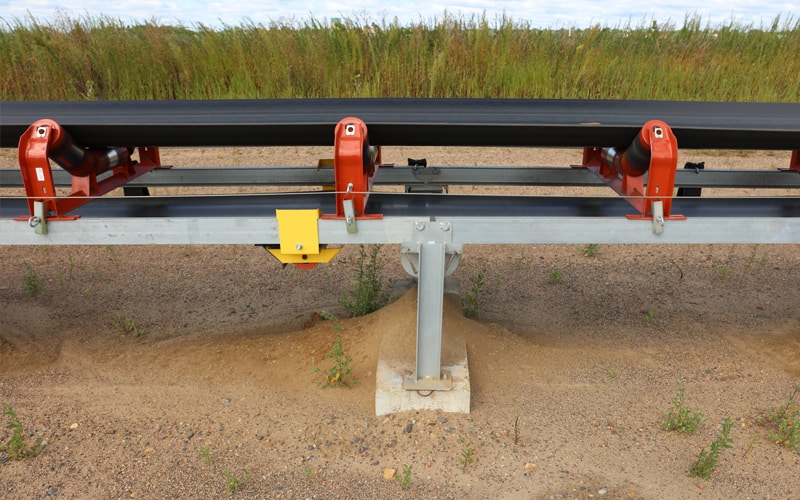Zip It
A New Quick-to-Install, Modular Overland Conveying System Makes Material Handling Reconfiguration Easy
In its second season and operating a brand new processing plant, Dakota Aggregates mines on 1,722 acres within the visionary University of Minnesota Outreach, Research and Education (UMore) Park. Located in Rosemount near the Twin Cities, the mine serves the metro area with a wide variety of construction aggregate products. The operation was designed with innovation in mind, particularly where material handling is concerned. The site spans three miles from north to south, and a mile and a half from east to west. Consequently, overland conveyor systems were chosen to efficiently transfer material from the face to the processing facility, while eliminating the costly use and resulting emission streams of loaders and haul trucks; and providing quiet operation while minimizing energy use and lowering operating costs per ton.
Initially, the challenge for Dakota Aggregates was finding a lower cost overland alternative versus that of custom-engineered, conventional overland systems – and most importantly, one that would allow them to easily and quickly reconfigure their overland systems to accommodate changing mining requirements each season.
Dakota Aggregates has a substantial 40-year lease on the university-owned land where melting glaciers had left behind a thick blanket of high-quality sand and gravel thousands of years ago. Mining this deposit is part of the overall sustainability focus of UMore Park. A few of the big benefits of this initiative is that the local region taps into the cost-efficiencies of a valuable and nearby source of aggregate products, while the university realizes an additional long-term revenue source. And, for every ton of gravel mined, a portion of the profit goes into a scholarship fund for geology and civil engineering students at the university. It’s a win-win deal for all and an example of innovation at its best.
With the latter spirit in mind, Dakota Aggregates approached its material handling challenges by consulting with Superior Industries, the Morris, Minnesota-based manufacturer of material processing and handling systems and components. Superior had recently launched its Zipline Conveyor, a pre-engineered, modular overland conveying system designed for quick, and almost tool-free installation. Dakota Aggregates is one of the first producers in the nation to take advantage of this new overland conveying solution. “It was refreshing to share our input on the system with the engineers at Superior and to work with them on various enhancements to this new product,” says Stacey Hannover, operations manager for the Dakota Aggregates plant, which processes more than 1.5 million tons of aggregate products annually.
The site mines from its furthest boundary and back toward the processing plant. “While we are generally pulling conveyors out and shortening the distance of conveying, we can easily add on sections in other areas of the operation. We needed flexibility at the right price point. With the Zipline Conveyor, we have ease of assembly and ease of onsite portability,” says Hannover.
The operation utilizes a total of 4,900-feet of modular conveyor sections (at lengths of 10-feet each and belt widths of 30- to 36-inches) which is currently divided into six different overland systems of 500- to up to 1000-feet. “It’s easy to reconfigure any one of our modular overland systems to cost-effectively meet our changing requirements each year. As an example, during this season, we easily pulled 250-feet out of one system. Also, while we generally operate on level ground, next season we will be moving a section to accommodate material transfer on an area with a 15-percent incline,” says Hannover. He adds that installation is “pretty much a breeze. Once we got the pattern down, three crew members marched right down the conveyor corridor and were able to assemble 1,000-feet of overland conveyor sections in a ten-hour day.” The crew used a forklift and a skid steer loader with no need for cranes or other heavy equipment.
Project Details
COMPANY
Dakota Aggregates
LOCATION
Rosemount, Minnesota
APPLICATION
Aggregates: Sand & Gravel
PRODUCT(S)
Zipline® Conveyor
Summary
Located near the Twin Cities, Dakota Aggregates’ mine serves the metro area with a wide variety of construction aggregate products. The site spans three miles from north to south, and a mile and a half from est to west. Overland conveyor systems were chosen for this operation to efficiently transfer material from the face to the processing facility, while eliminating the costly use and resulting emission streams of loaders and haul trucks; resulting in a more quiet operation and minimal energy use for a lower operating cost per ton.
Engineering perspective
“We began with the mission of being tool-free in installation requirements regarding the entire intermediate area between the head and tail sections,” says Travis Thooft, a member of the Superior Industries engineering team. He explains that this required creating a new type of “fastening system” that is structurally sound and reliable, yet is quick and easy to use in the field.
“When you consider the typical way to put things together, the industry standard is basically weld or bolt. We took it a step further by eliminating bolts and replacing them where possible with a ‘fixed-pin’ connection. We wanted to eliminate the need to bring out a set of wrenches for most installations,” says Thooft. He estimates that the new design can cut installation time by up to 75 percent. “Basically, you hook in one end and then the other, with the whole setup for a 10-foot section taking just about five minutes,” he says.
Thooft goes on to explain that the specification process starts by defining the overall length of the overland system, and the required horsepower. The system includes a pre-engineered head assembly and tail section, and is designed with off-the-shelf components for easy sourcing of replacement idlers and pulleys. “Producers can customize with options such as self-aligning troughing idlers or special return trainers, idler guards, and belt cleaners; or a longer or different type of gravity takeup for example,” he adds.
When compared to the spec-by-spec, highly engineered system, Thooft says that the Zipline Conveyor system is a lower cost overland alternative. “While it’s lighter in weight, it offers the structural strength of the conventional overland system. Its big advantage is its ‘modularity factor and unique fastening system,’ which allows easy structural additions in the future; and easy site reconfigurations as needed. It also allows operations to choose (depending upon the project) between renting modular sections from their local equipment dealer or purchasing a package of sections that they can customize within a given set of parameters,” he says.
Driving overland solutions
What are the key drivers behind more and more operations turning to overland conveyor solutions? Certainly overland conveyors offer cost-effective material transport within a wide spectrum of capacities – and when used in place of loaders and haul trucks, operations are significantly reducing fuel costs and expenses due to labor, workers’ compensation, MSHA training, emissions, maintenance and engine depreciation.
Another key driver is ever-tightening environmental regulations. While individual mobile haulage units emit and stir noise and air pollution along the entire transfer path, overland conveyor systems offers quiet and environmentally-sound material transport.
With the advent of the pre-engineered and quick-to-install, modular overland system, producers such as Dakota Aggregates can acquire a system with a lesser initial capital investment than that of conventional systems, and can operate with greater efficiency, flexibility and sustainability into the future.
Have questions? Need more information? Complete the form below and we will follow up shortly.
Request More Info
See our privacy policy.



